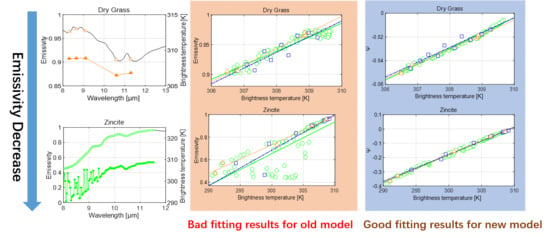Temperature and Emissivity Smoothing Separation with Nonlinear Relation of Brightness Temperature and Emissivity for Thermal Infrared Sensors
Abstract
1. Introduction
2. Backgrounds and Basic Methods
2.1. Imaging Systems
2.2. The Radiative Transfer Model
2.3. Temperature and Emissivity Separation Algorithm
2.4. Optimized Smoothing for Temperature Emissivity Separation Algorithm
3. Nonlinear Relation Reasoning and the Proposed Method
3.1. Nonlinear Relation Reasoning
3.1.1. Linear Hypothesis
3.1.2. Nonlinear Hypothesis
3.2. Smoothing Temperature and Emissivity Separation Algorithm Based on Nonlinear Constraint
4. Experiment and Analysis
4.1. Results Using Synthetic Data
4.1.1. Emissivity Retrieval Accuracy for Different Kinds of Emissivity Level
4.1.2. Smoothness Effect for Various Aatmospheric Conditions and Sensors
4.1.3. The Effect of Various Specific Atmospheric Conditions and Noise Levels
4.2. Results Using ASTER Standard Data
5. Conclusions
Author Contributions
Funding
Acknowledgments
Conflicts of Interest
References
- Van der Meer, F.D.; Van der Werff, H.M.A.; Van Ruitenbeek, F.J.A.; Hecker, C.A.; Bakker, W.H.; Noomen, W.F.; Van der Meide, M.; Carranza, E.J.M.; de Smeth, J.B.; Woldai, T. Multi- and hyperspectral geologic remote sensing: A review. Int. J. Appl. Earth Observ. Geoinf. 2012, 14, 112–128. [Google Scholar] [CrossRef]
- Pieri, D.; Abrams, M. ASTER watches the world’s volcanoes: A new paradigm for volcanological observations from orbit. J. Volcanol. Geotherm. Res. 2004, 135, 13–28. [Google Scholar] [CrossRef]
- Foster, L.A.; Brock, B.W.; Cutler, M.E.J.; Diotri, F. A physically based method for estimating supraglacial debris thickness from thermal band remote-sensing data. J. Glaciol. 2012, 58, 677–691. [Google Scholar] [CrossRef]
- Scheidt, S.; Ramsey, M.; Lancaster, N. Determining soil moisture and sediment availability at white sands dune field, New Mexico, from apparent thermal inertia data. J. Geophys. Res. Earth Surf. 2010, 115. [Google Scholar] [CrossRef]
- Weng, Q.; Rajasekar, U.; Hu, X. Modeling urban heat islands and their relationship with impervious surface and vegetation abundance by using ASTER images. IEEE Trans. Geosci. Remote Sens. 2011, 49, 4080–4089. [Google Scholar] [CrossRef]
- French, A.N.; Schmugge, T.J.; Ritchie, J.C.; Hsu, A.; Jacob, F.; Ogawa, K. Detecting land cover change at the Jornada Experimental Range, New Mexico with ASTER emissivities. Remote Sens. Environ. 2008, 112, 1730–1748. [Google Scholar] [CrossRef]
- Schneider, P.; Hook, S.J.; Radocinski, R.D.; Corlett, G.K.; Hulley, G.C.; Schladow, S.G.; Steissber, T.E. Satellite observations indicate rapid warming trend for lakes in California and Nevada. Geophys. Res. Lett. 2009, 36, 355. [Google Scholar] [CrossRef]
- Mallick, K.; Jarvis, J.A.; Boegh, E.; Fisher, J.B.; Drewry, D.T.; Tu, K.P.; Hook, S.J.; Hulley, G.; Ardo, J.; Beringer, J.; et al. A surface temperature initiated closure (STIC) for surface energy balance fluxes. Remote Sens. Environ. 2014, 141, 243–261. [Google Scholar] [CrossRef]
- Hulley, G.; Veraverbeke, S.; Hook, S. Thermal-based techniques for land cover change detection using a new dynamic MODIS multispectral emissivity product (MOD21). Remote Sens. Environ. 2014, 140, 755–765. [Google Scholar] [CrossRef]
- Anderson, M.C.; Hain, C.; Wardlow, B.; Pimstein, A.; Mecikalski, J.R.; Kustas, W.P. Evaluation of drought indices based on thermal remote sensing of evapotranspiration over the continental United States. J. Climate 2011, 24, 2025–2044. [Google Scholar] [CrossRef]
- Rhee, J.; Im, J.; Carbone, G.J. Monitoring agricultural drought for arid and humid regions using multi-sensor remote sensing data. Remote Sens. Environ. 2010, 114, 2875–2887. [Google Scholar] [CrossRef]
- Gillespie, A.; Rokugawa, S.; Matsunaga, T.; Cothern, J.S.; Hook, S.; Kahle, A.B. A temperature and emissivity separation algorithm for advanced spaceborne thermal emission and reflection radiometer (ASTER) images. IEEE Trans. Geosci. Remote Sens. 1998, 36, 1113–1126. [Google Scholar] [CrossRef]
- Jimenez-Munoz; Juan, C.; Sobrino, J.A.; Gillespie, A.R. Surface emissivity retrieval from airborne hyperspectral scanner data: Insights on atmospheric correction and noise removal. IEEE Geosci. Remote Sens. Lett. 2012, 9, 180–184. [Google Scholar] [CrossRef]
- Wang, H.; Xiao, Q.; Li, H.; Zhong, B. Temperature and emissivity separation algorithm for TASI airborne thermal hyperspectral data. In Proceedings of the International Conference on Electronics, Communications and Control (ICECC), Ningbo, China, 9–11 September 2011; pp. 1075–1078. [Google Scholar] [CrossRef]
- Coll, C.; Caselles, V.; Valor, E.; Niclos, R.; Sanchez, J.M.; Galve, J.M.; Mira, M. Temperature and emissivity separation from ASTER data for low spectral contrast surfaces. Remote Sens. Environ. 2007, 110, 162–175. [Google Scholar] [CrossRef]
- Sobrino, J.A.; Jiménez-Muñoz, J.C.; Balick, L.; Gillespie, A.R.; Sabol, D.A.; Gustafson, W.T. Accuracy of ASTER level-2 thermal-infrared standard products of an agricultural area in Spain. Remote Sens. Environ. 2007, 106, 146–153. [Google Scholar] [CrossRef]
- Pivovarník, M. Improved temperature and emissivity separation algorithm for multispectral and hyperspectral sensors. IEEE Trans. Geosci. Remote Sens. 2017, 55, 1944–1953. [Google Scholar] [CrossRef]
- Valor, E.; Coll, C.; Caselles, V. The Adjusted Normalized Emissivity Method (ANEM) for land surface temperature and emissivity recovery. In Proceedings of the IEEE International Geoscience & Remote Sensing Symposium, Toulouse, France, 21–25 July 2003. [Google Scholar] [CrossRef]
- Fernández-Renau, A.; Gómez, J.A.; de Miguel, E. The INTA AHS system. Proc. SPIE 2005, 5978, 59781L. [Google Scholar] [CrossRef]
- Allard, J.-P. Airborne measurements in the longwave infrared using an imaging hyperspectral sensor. In Proceedings of the Spie Defense & Security Symposium International Society for Optics and Photonics, Orlando, FL, USA, 17 April 2008; p. 6954. [Google Scholar] [CrossRef]
- Sobrino, J.A.; Juan, C. Land surface temperature derived from airborne hyperspectral scanner thermal infrared data. Remote Sens. Environ. 2006, 102, 99–115. [Google Scholar] [CrossRef]
- Cubero-Castan, M.; Briottet, X.; Achard, V.; Shimoni, M.; Chanussot, J. The comparability of aggregated emissivity and temperature of heterogeneous pixel to conventional TES methods. In Proceedings of the 5th IEEE WHISPERS, Gainesville, FL, USA, 26–28 June 2013. [Google Scholar]
- Pipia, L.; Perez, F.; Tarda, A.; Martinez, L.; Arbiol, R. Simultaneous usage of optic and thermal hyperspectral sensors for crop water stress characterization. In Proceedings of the IEEE International Geoscience and Remote Sensing Symposium (IGARSS), Munich, Germany, 22–27 July 2012; pp. 6661–6664. [Google Scholar] [CrossRef]
- Mushkin, A.; Balick, L.K.; Gillespie, A.R. Temperature/emissivity separation of MTI data using the terra/ASTER TES algorithm. Proc. SPIE 2002, 4725, 328–337. [Google Scholar] [CrossRef]
- Hulley, G.C.; Hook, S.J. Generating consistent land surface temperature and emissivity products between ASTER and MODIS data for earth science research. IEEE Trans. Geosci. Remote Sens. 2011, 49, 1304–1315. [Google Scholar] [CrossRef]
- Jiménez-Muñoz, J.-C.; Sobrino, J.A.; Mattar, C.; Hulley, G.; Gottsche, F.-M. Temperature and emissivity separation from MSG/SEVIRI data. IEEE Trans. Geosci. Remote Sens. 2014, 52, 5937–5951. [Google Scholar] [CrossRef]
- Baldridge, A.M.; Hook, S.J.; Grove, C.I.; Rivera, G. The ASTER spectral library version 2.0. Remote Sens. Environ. 2009, 113, 711–715. [Google Scholar] [CrossRef]
- Sabol, D.E.; Gillespie, A.R.; Abbott, E.; Yamada, G. Field validation of the ASTER temperature-emissivity separation algorithm. Remote Sens. Environ. 2009, 113, 2328–2344. [Google Scholar] [CrossRef]
- Berk, A.; Andreson, G.P.; Acharya, K.P.; Bernstein, L.S.; Muratov, L.; Lee, J.; Fox, M.; Adler-Golden, S.M.; Chetwynd, J.H., Jr.; Hoke, M.L.; et al. MODTRAN5: 2006 update. In Proceedings of the Algorithms and Technologies for Multispectral, Hyperspectral, and Ultraspectral Imagery XII, Orlando, FL, USA, 8 May 2006; Volume 6233, p. 62331F. [Google Scholar] [CrossRef]
- Tonooka, H.; Palluconi, F.D.; Hook, S.J.; Matsunaga, T. Vicarious calibration of ASTER thermal infrared bands. IEEE Trans. Geosci. Remote Sens. 2005, 43, 2733–2746. [Google Scholar] [CrossRef]
- Tonooka, H. Accurate atmospheric correction of ASTER thermal infrared imagery using the WVS method. IEEE Trans. Geosci. Remote Sens. 2005, 43, 2778–2792. [Google Scholar] [CrossRef]
- Tonooka, H.; Palluconi, F.D. Validation of ASTER/TIR standard atmospheric correction using water surfaces. IEEE Trans. Geosci. Remote Sens. 2005, 43, 2769–2777. [Google Scholar] [CrossRef]
- Tonooka, H.; Palluconi, F.D. Verification of the ASTER/TIR atmospheric correction algorithm based on water surface emissivity retrieved. Proc. SPIE 2002, 4486, 51–58. [Google Scholar] [CrossRef]
- Chedin, A.; Scott, N.A.; Wahiche, C.; Moulinier, P. The improved initialization inversion method: A high resolution physical method for temperature retrievals from satellites of the TIROS-N series. J. Climate Appl. Meteorol. 1985, 24, 128–143. [Google Scholar] [CrossRef]
- Chevallier, F.; Chéruy, F.; Scott, N.A.; Chédin, A. A neural network approach for a fast and accurate computation of a longwave radiative budget. J. Appl. Meteorol. 1998, 37, 1385–1397. [Google Scholar] [CrossRef]
- Pérez, P.; Lluís, V.E.; Coll, C.; César. Comparison and evaluation of the TES and ANEM algorithms for land surface temperature and emissivity separation over the area of Valencia, Spain. Remote Sens. 2017, 9, 1251. [Google Scholar] [CrossRef]
- Abrams, M.; Hook, S.; Ramachandran, B. ASTER User Handbook, Version 2; Jet Propulsion Laboratory: La Cañada Flintridge, CA, USA, 2002; Volume 4800, p. 135. [Google Scholar]
- Gillespie, A.R.; Abbott, E.A.; Gilson, L.; Hulley, G.; Jiménez-Muñoz, J.-C.; Sobrino, J.A. Residual errors in ASTER temperature and emissivity standard products AST08 and AST05. Remote Sens. Environ. 2011, 115, 3681–3694. [Google Scholar] [CrossRef]
- Niclòs, R.; Doña, C.; Valor, E.; Bisquert, M.; Niclòs, R.; Doña, C.; Valor, E.; Bisquert, M. Thermal-infrared spectral and angular characterization of crude oil and seawater emissivities for oil slick identification. IEEE Trans. Geosci. Remote Sens. 2014, 52, 5387–5395. [Google Scholar] [CrossRef]











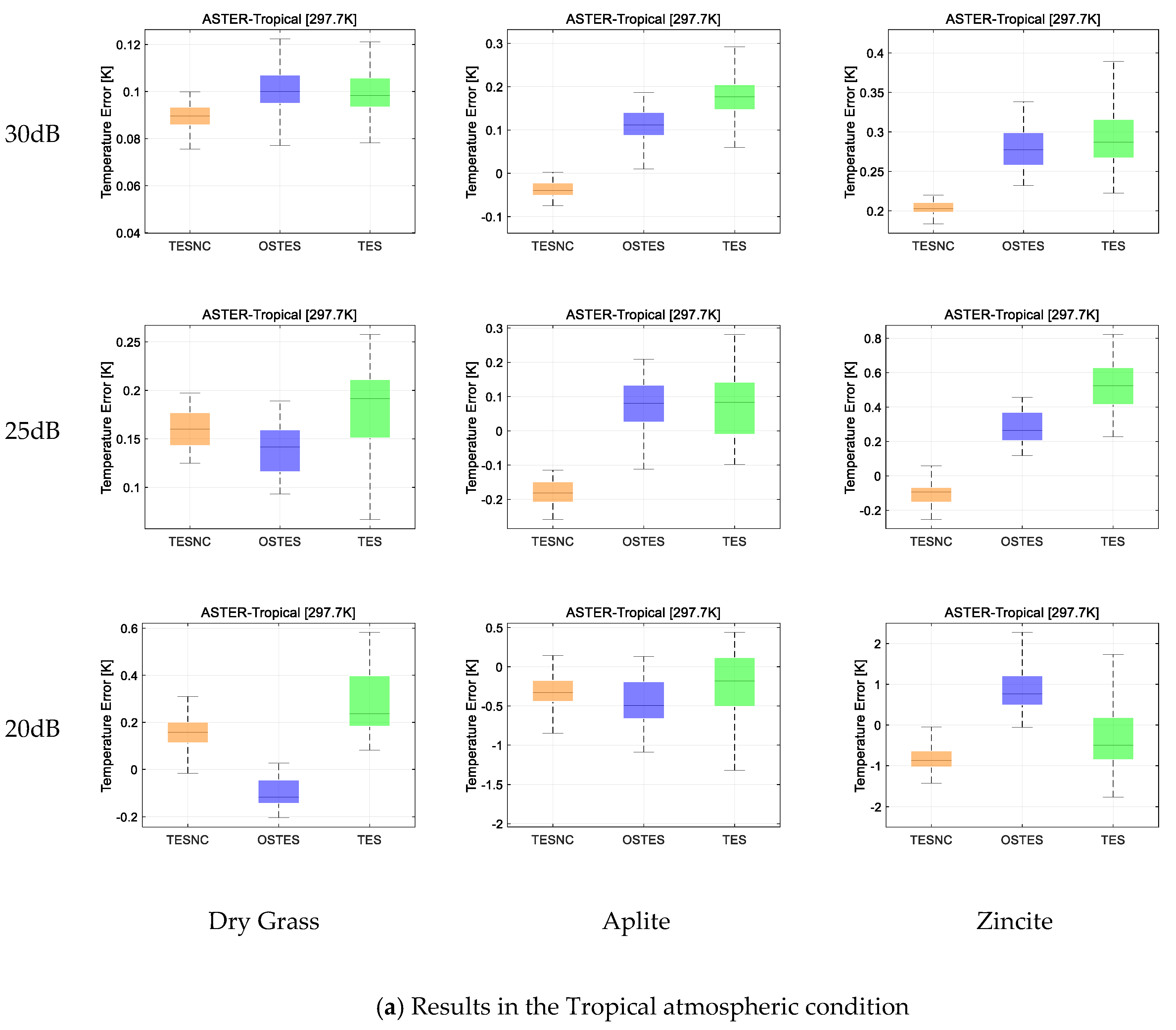
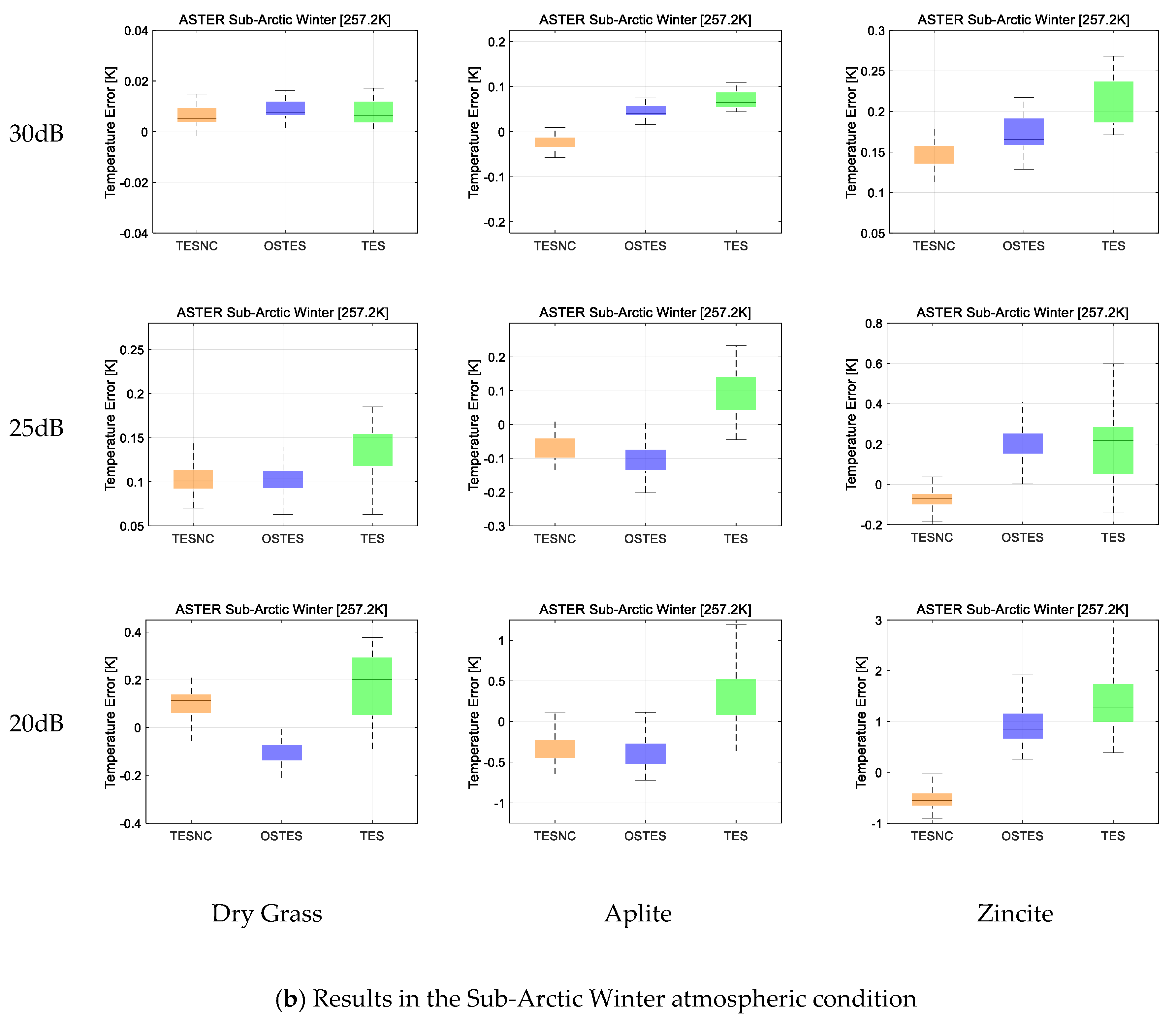
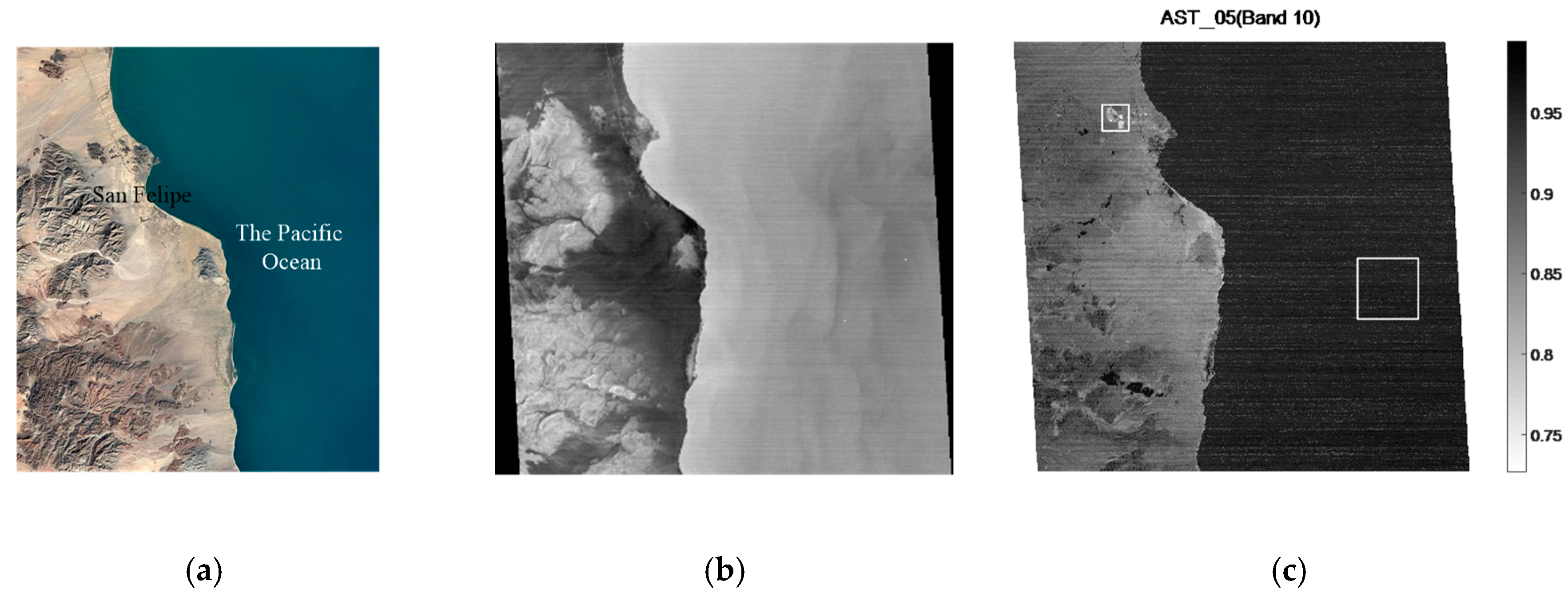

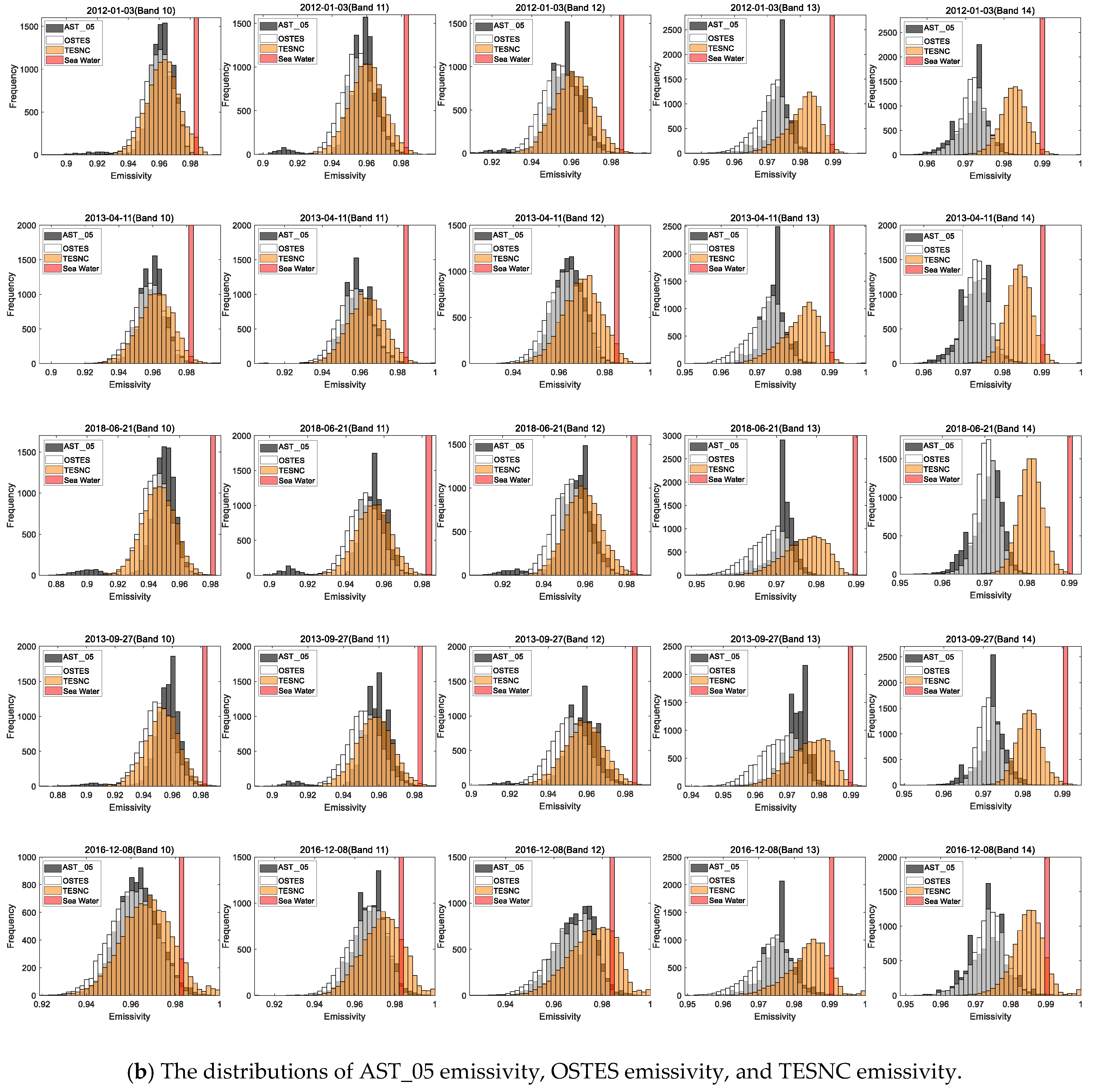

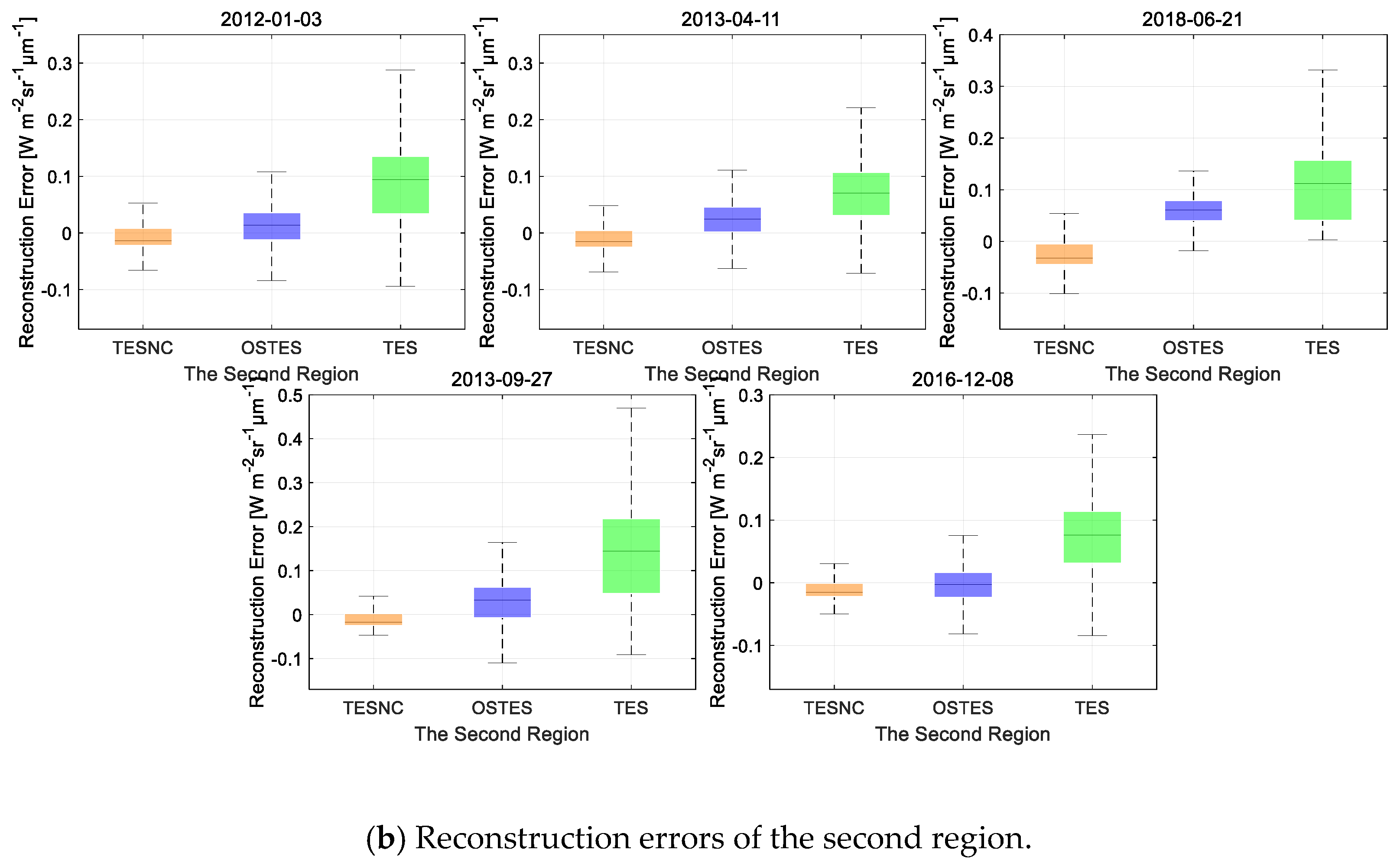
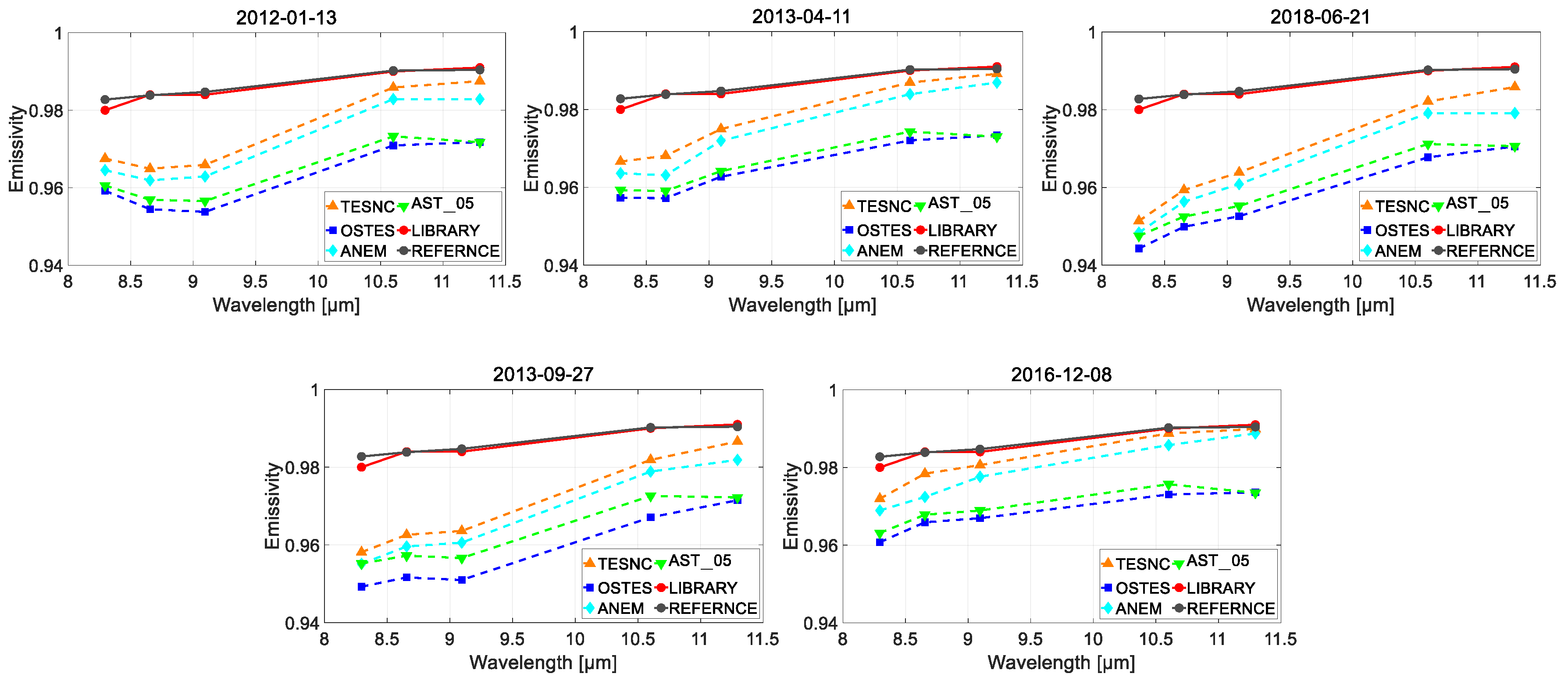
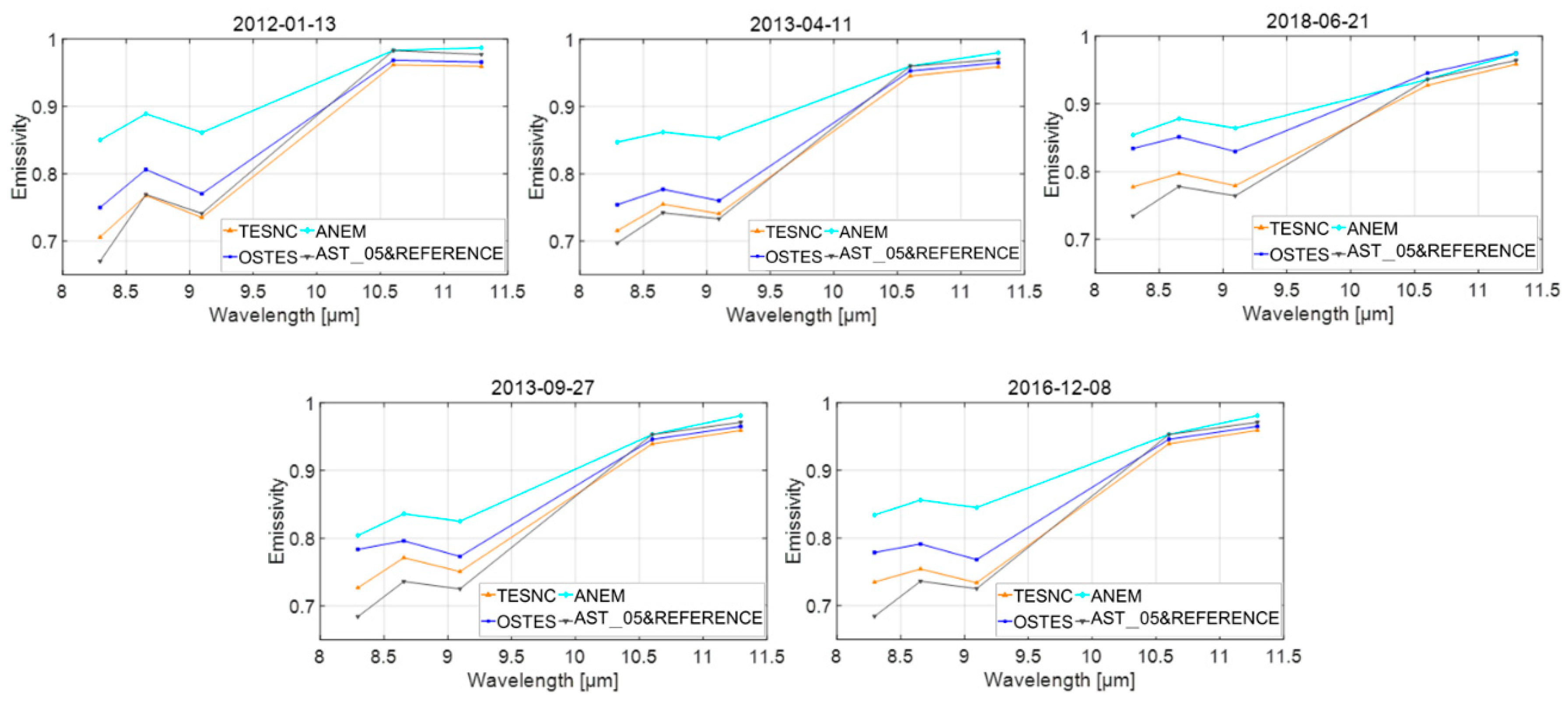
| Sensors | a | b | c | R-square |
|---|---|---|---|---|
| ASTER | 0.9802 | −0.7572 | 0.831 | 0.9688 |
| AHS | 0.9764 | −0.8202 | 0.9364 | 0.9849 |
| Telops Hyper-Cam | 0.9787 | −0.7511 | 0.8918 | 0.9843 |
| 1. | |
| 2. | Find and by solving |
| 3. | Estimate emissivities |
| 4. | Estimate spectrum |
| 5. | |
| 6. | return |
| Input: Land-leaveing radiance , Downwelling radiance and Iterative times . Output: Emissivities for each band and Land surface temperature . |
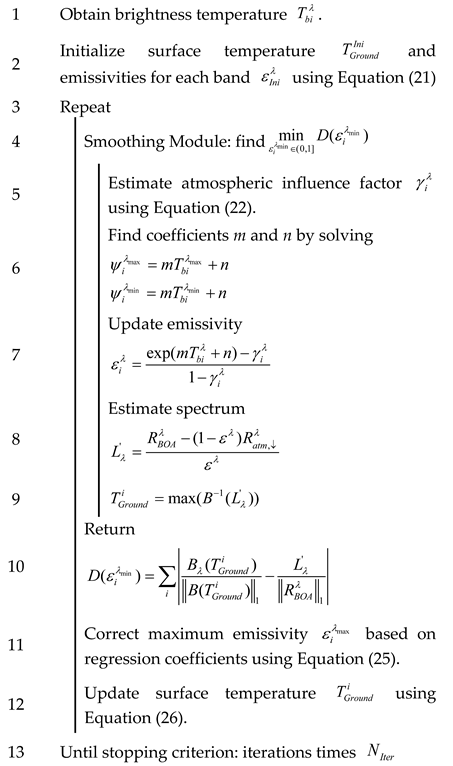 |
| Sensor | MMD | SD and RMSE of Temperature Error [K] | TESNC | OSTES | TES |
|---|---|---|---|---|---|
| ASTER | MMD < 0.180 | SD | 0.45 | 0.42 | 0.85 |
| RMSE | 0.59 | 0.57 | 0.93 | ||
| MMD > 0.180 | SD | 0.70 | 0.85 | 1.20 | |
| MMD < 0.375 | RMSE | 0.72 | 1.45 | 1.56 | |
| MMD > 0.375 | SD | 0.80 | 1.36 | 1.94 | |
| RMSE | 0.87 | 1.63 | 1.95 | ||
| AHS | MMD < 0.189 | SD | 0.40 | 0.45 | 0.80 |
| RMSE | 0.42 | 0.79 | 1.00 | ||
| MMD > 0.189 | SD | 0.57 | 0.80 | 1.16 | |
| MMD < 0.408 | RMSE | 0.72 | 1.08 | 2.05 | |
| MMD > 0.408 | SD | 0.60 | 1.16 | 1.54 | |
| RMSE | 0.75 | 1.19 | 1.70 | ||
| Telops Hyper-Cam | MMD < 0.216 | SD | 0.29 | 0.29 | 0.69 |
| RMSE | 0.30 | 0.29 | 0.86 | ||
| MMD > 0.216 | SD | 0.27 | 0.63 | 1.00 | |
| MMD < 0.458 | RMSE | 0.27 | 0.69 | 2.00 | |
| MMD > 0.458 | SD | 0.32 | 0.77 | 1.15 | |
| RMSE | 0.33 | 1.17 | 1.82 |
| Location | Acq dat (UTC) | Cloud Coverage |
|---|---|---|
| San Felipe, Mexico | 3 March 2012 (05:52:49) | 0 |
| San Felipe, Mexico | 11 April 2013 (05:53:20) | 0 |
| San Felipe, Mexico | 21 June 2018 (05:48:14) | 0 |
| San Felipe, Mexico | 27 September 2013 (05:46:48) | 0 |
| San Felipe, Mexico | 8 December 2016 (05:46:57) | 0 |
| Scenes | The First Region [W m−2 sr−1 μm−1] | The Second Region [W m−2 sr−1 μm−1] | ||||
|---|---|---|---|---|---|---|
| TESNC | OSTES | TES | TESNC | OSTES | TES | |
| 3 January 2012 (05:52:49) | 0.018 | 0.035 | 0.037 | 0.024 | 0.042 | 0.13 |
| 11 April 2013 (05:53:20) | 0.028 | 0.027 | 0.035 | 0.023 | 0.042 | 0.10 |
| 21 June 2018 (05:48:14) | 0.034 | 0.024 | 0.053 | 0.048 | 0.065 | 0.14 |
| 27 September 2013 (05:46:48) | 0.027 | 0.027 | 0.052 | 0.027 | 0.063 | 0.19 |
| 8 December 2016 (05:46:57) | 0.022 | 0.040 | 0.033 | 0.021 | 0.027 | 0.10 |
© 2019 by the authors. Licensee MDPI, Basel, Switzerland. This article is an open access article distributed under the terms and conditions of the Creative Commons Attribution (CC BY) license (http://creativecommons.org/licenses/by/4.0/).
Share and Cite
Miao, X.; Zhang, Y.; Zhang, J.; Zhou, X. Temperature and Emissivity Smoothing Separation with Nonlinear Relation of Brightness Temperature and Emissivity for Thermal Infrared Sensors. Remote Sens. 2019, 11, 2959. https://doi.org/10.3390/rs11242959
Miao X, Zhang Y, Zhang J, Zhou X. Temperature and Emissivity Smoothing Separation with Nonlinear Relation of Brightness Temperature and Emissivity for Thermal Infrared Sensors. Remote Sensing. 2019; 11(24):2959. https://doi.org/10.3390/rs11242959
Chicago/Turabian StyleMiao, Xinyuan, Ye Zhang, Junping Zhang, and Xinyu Zhou. 2019. "Temperature and Emissivity Smoothing Separation with Nonlinear Relation of Brightness Temperature and Emissivity for Thermal Infrared Sensors" Remote Sensing 11, no. 24: 2959. https://doi.org/10.3390/rs11242959
APA StyleMiao, X., Zhang, Y., Zhang, J., & Zhou, X. (2019). Temperature and Emissivity Smoothing Separation with Nonlinear Relation of Brightness Temperature and Emissivity for Thermal Infrared Sensors. Remote Sensing, 11(24), 2959. https://doi.org/10.3390/rs11242959




